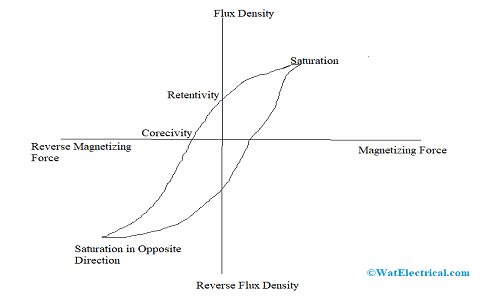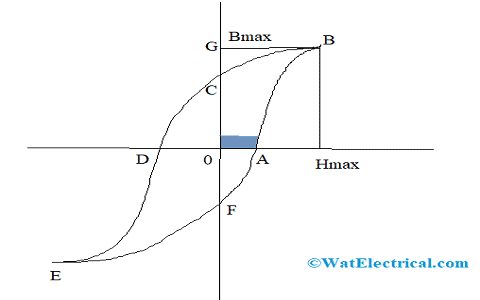The term ‘Hysteresis’ was derived from the Ancient Greek Word and the meaning of this term is a deficiency of leg behind. While defining the property of magnetic material, “James Alfred Ewing” proposed this term in the year 1890. The property of hysteresis is observed in the concepts of chemistry, economics, physics, and engineering as well. This characteristic was included in most of the artificial systems such as in Schmitt triggers and thermostats.
In ancient times, many attempts illustrating hysteresis in mechanical structures were done by James Maxwell. Whereas a formal mathematical hypothesis of systems including hysteresis was developed in the year 1970. And today this article completely focuses on explaining what is hysteresis loss, its magnitude, affected factors, and applications?
What is Hysteresis Loss?
The amount of work exerted by the magnetizing force in opposition to the interior friction of the magnetic molecules generates heat and the amount of energy that is wasted as heat because of hysteresis is termed Hysteresis Loss.
When there is the application of magnetization force on the magnetic substance, then the molecules inside the substance get aligned in a specific direction. And when the applied magnetic force is changed in opposite direction, then the internal friction of the molecules contradicts the reversal of magnetism which results in Magnetic Hysteresis. So, to get rid of this internal friction, there will be the application of some magnetizing force.

Curve with Magnetization Properties
To have a clear understanding of this concept, consider an electric machine. As there is a development of hysteresis loss only when there is magnetism opposition where this might take place in magnetic components of electrical devices. When the machine’s temperature level is increased, these outcomes in energy wastage in the form of heat which seems to be an adverse impact on machines. Thus, because an appropriate magnetic substance that has less hysteresis loss having constricted space for hysteresis loop is implemented for constructing this electrical equipment.
Formula
The hysteresis loss formula can be known by considering the hysteresis loop in a ferromagnetic substance. When the MMF is raised from null to greatest value, then the accumulated energy per each unit volume of material is given as follows:

Hysteresis Curve
ʃ-BfBb = H dB which is the area of the region ‘ABGO’
When the ‘H’ value decreases to ‘zero’ and the dB value being negative, then the energy provided by the magnetic field is given by
ʃBbBc = H dB which is the area of the region ‘CBG’
Here, the amount of energy that is not recovered is shown by the area ‘ABCO’ that represents the energy loss in the form of heat and this is called as hysteresis loss in the transformer. The entire hysteresis loop per each cycle is shown by the area of the loop ‘ABCDEFA’ which is represented as Wh. This loss per ‘V’ volume of material when operated at ‘f’ Hz is
Ph = whVf Watts
To eliminate the necessity of computation of the loop section, Steinmetz provided a practical formula to calculate hysteresis loss depending on the experimental observations
Ph = khf Bmn W/m3
Here, ‘kh’ represents the characteristic constant of the loop section
‘Bm’ represents the greatest value of flux density
‘n’ represents Steinmetz exponent where this ranges between 1.5 – 2.5 based on the type of material
So, the unit of hysteresis loss in Watts/metere3
Magnitude of Hysteresis Loss
Let us consider a strip having a minimum thickness of dB on the loop as depicted in the below picture.
For any current value, the subsequent flux value is given by
ψ = B × A webers
For less charge, the work done is given by
dW = no. of ampere-turns × flux change
- NI (dB × A) joules
- N (HI/n) (dB × A) Joules
- H (AI) dB Joules
The total amount of work that is done per each magnetization cycle is the result which is obtained by integrating the above dW equation
W = ʃ H (AI) dB = AI ʃ H dB Joules
And, when ‘f’ is the total magnetization cycle made per second, then
Hysteresis loss in a magnetic substance per each unit volume is
Ph/m3 = ηBmax1.6f Watts
Here, Bmax is flux density’s maximum value
V is magnetic substance volume
Affected Factors
There exists multiple factors those show impact on hysteresis loss where few of the factors affecting hysteresis loss are given by:
- The loss is mainly based on the performance of magnetic substance
- There are different saturation points for various ‘B’ values and because of this hysteresis loop gets impacted
- The size and shape of the loop are based on the initial point of the specimen
- When the magnetic substance is not magnetized easily, this results in a large hysteresis loop which is undesirable
- For a good magnetic substance, the loop will be narrow
How do we Reduce Hysteresis Losses?
- This loss can be minimized by implementing substances that have minimal loop sections. For this purpose, high-graded silicon steel is used for the construction of the transformer’s core section as it has a minimal loop area.
- Also, a unique core substance can be used that minimizes the ‘0’ or non-zero flux density when there is no current flow.
- Also, when more no. of laminations are used which have less distance between plates can be used for minimizing the loss.
- Through the selection of softcore, the loss gets decreased. Silicon steel is a good example
Applications
The applications of hysteresis losses include of following:
- Used in control systems for filtering of signals
- This concept is implemented in the domain of aerodynamics when decreasing the angle of attack of the wing after stall
- Utilized in ferromagnets in order to retain their memory
- Also stated in respiratory physiology while observing the compliance of lung at the time of inspiration
- It is widely used in labor economics
- Also applicable in the domains of neuroscience, immunology, voice and speech, and genetics
Know more about Load Factor.
Know more about Magnetism and Electromagnetism MCQs.
On the whole, this is the detailed concept of hysteresis. This article has given a detailed explanation of hysteresis loss, its formula, affected factors, magnitude, and applications. Know, what are the types of hysteresis and how they are represented?